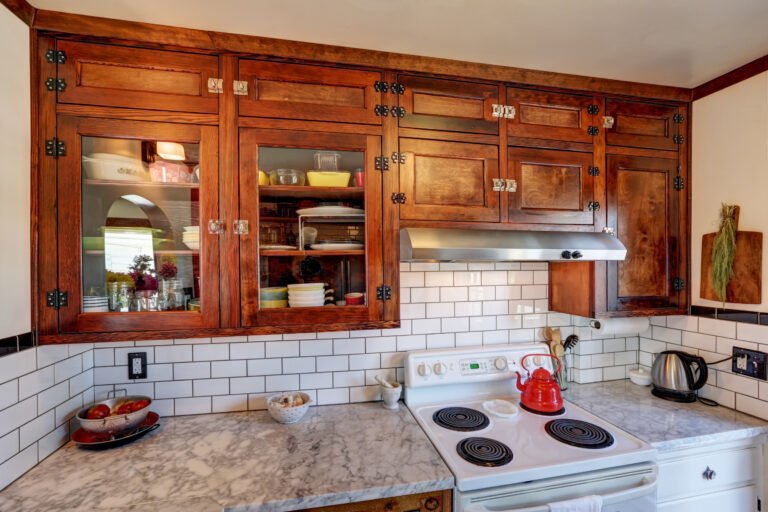The 21st century is about gourmet food, delicacies, and proper plating. So, no wonder fancier, heavier dishes, utensils, pans, and pots are flooding kitchens. And all these things go into the cabinets! But, what many of us forget is that even cabinets have limitations and may fall and break when overburdened.
So, how much weight can kitchen cabinets hold? And how do you reinforce them to hold more? Let’s find out.
According to the Kitchen Cabinet Manufacturers Association, the average kitchen cabinet can hold 600 pounds or 272 kilograms. Of course, this capacity depends on various factors, but most wall cabinets would carry a minimum of 500 pounds or 226 kilograms of weight.
Standards Of Kitchen Cabinets Weight Capacity:
- The base of a medium-sized, 100 lb cabinet (roughly measuring around 18” X 18” X 21”) can have a load-bearing capacity of 250 lbs or 113 kgs. But obviously, this includes the weight of the cabinet material and even the fasteners. Still, it is enough to store several dishes, pots, and pans efficiently.
- Cabinets usually have two doors, and this added door weight reduces the load-bearing capacity of cabinets by 30-40lbs.
- An upper cabinet usually has zero to no shelving. This reduces the cabinet’s overall dead weight and allows you to place more stuff in it than a base cabinet.
Standards Of Kitchen Cabinet Hardware:
Kitchen Cabinet Screw Strength:
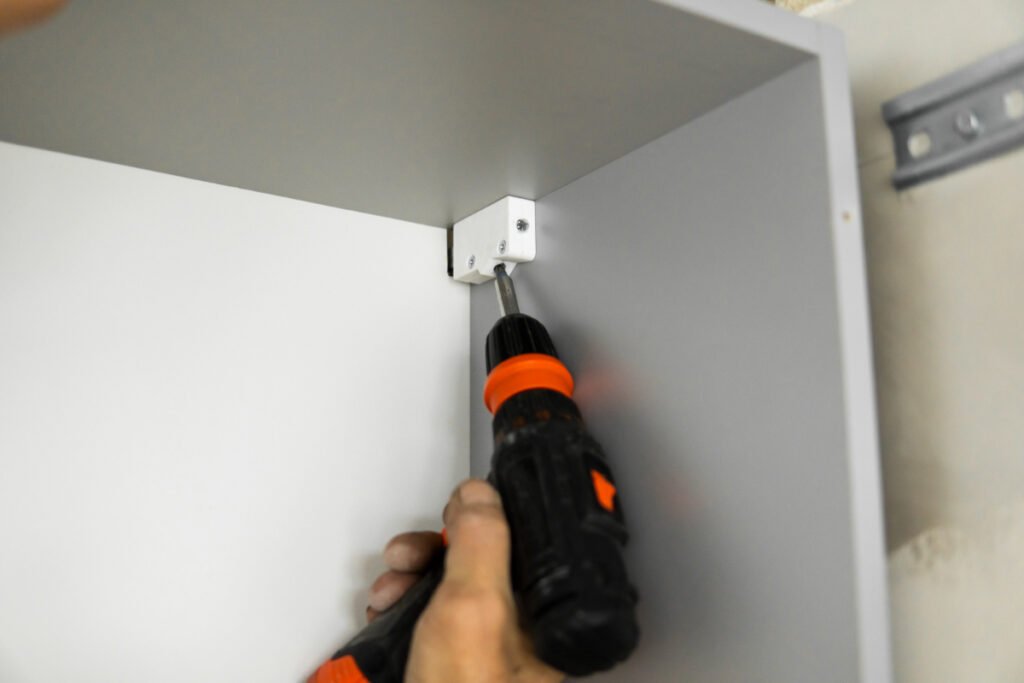
Screws are essential tools to secure any kitchen cabinet, which is why durable, good-quality screws are a must to reinforce kitchen cabinets and improve their weight capacity.
Generally, many households use a standard 100psi (pounds per square inch) cabinet screw to support their upper cabinets. Though cheaper, these are not that efficient in high-traffic or heavy-duty kitchen cabinets and may cause the cabinet to fall.
So instead, it’s advisable to pick a self-drilling screw that will successfully hold about 200 psi weight and carry more stuff.
However, if you want to store hefty appliances like mixers, blenders, and deep fryers in your kitchen cabinets, you should instead use lag bolts and washers that carry about 500 psi weight.
So, in a nutshell, cabinet screws are the right choice if you keep plates and crockery in your cabinets, but use larger washer-head screws if you need room for a heavy item.
How many screws should hold up a kitchen cabinet?
Upper cabinets need to have at least four screws that penetrate from the top and sides of the cabinet box. Plus, the maximum distance between 2 screws should not exceed 300mm c/c for an optimal weight-carrying capacity.
Cabinet Shelf Clip Strength:
Shelving is an essential part of any upper, base, or corner cabinet, and its load-carrying capacity generally depends on the material of the clips that support them. For example, if you use metal or stainless steel clips under your cabinet shelf, you can put a load of 100 pounds or 45 kg on it, enough to store grains, fruit tins, and some devices efficiently.
However, if you are using cheaper plastic clips, you can load your cabinet shelf to a maximum of 40 pounds or 18kg, enough to carry all of your plates and crockery without failing.
Wall Stud And Joist Strength
Any overhead or upper cabinet weight falls on the wall stud, support beams, and ceiling joists. Thankfully, they already have a high weight rating of about 25,000 pounds, which is much higher than the recommended weight for any cabinetry. So you don’t need to worry about them failing.
Load-Bearing Capacities Of Various Kitchen Cabinet Materials:
Kitchen cabinets come in various sizes and materials, and each has a different load-bearing capacity based on its tensile strength. Let’s find out which cabinet material can hold the maximum weight!
How Much Weight Can Metal Or Steel Kitchen Cabinets Hold?
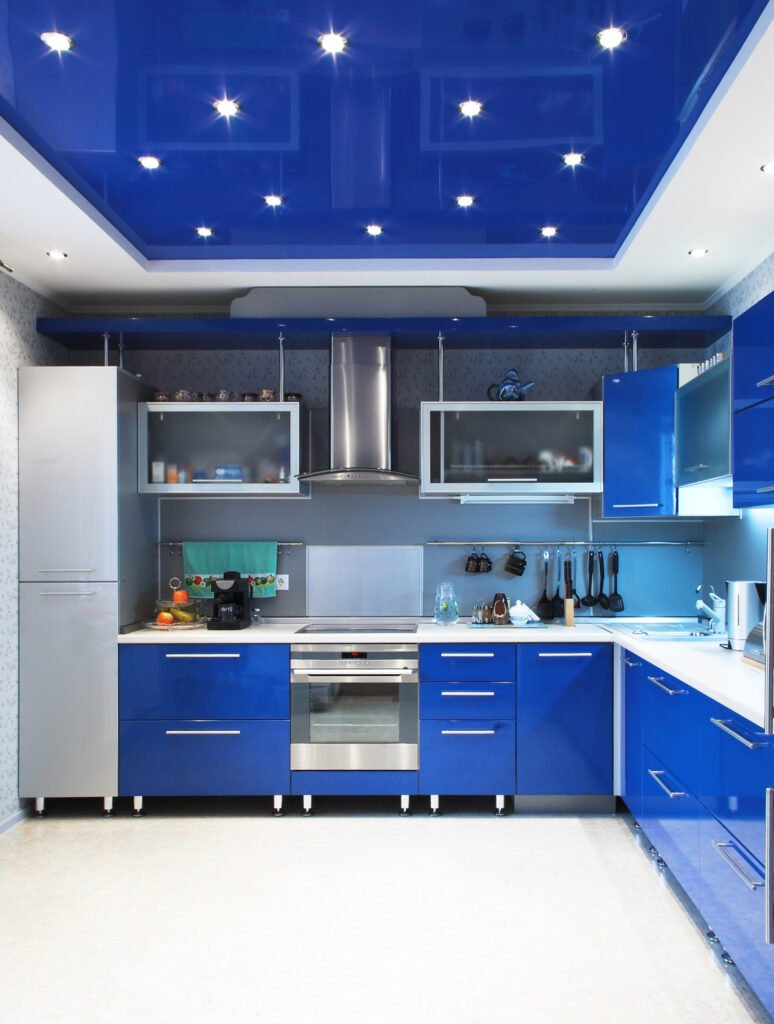
Metal or steel cabinets are the strongest and can successfully hold up to 500 pounds or 226 kilograms of weight. Smaller metal cabinets, roughly measuring around 42” X 36” X 18”, can hold about 400 pounds, whereas larger, welded cabinets are more secure and can store grain sacks and appliances.
The key here is to use support anchors at the back panel of the cabinet and fasten them directly to the walls to help the cabinet carry more weight.
You can directly weld the shelf inside the cabinet instead of using additional fasteners like clips, hinge, or brackets and have a stronger joint.
How Much Weight Can A Plywood Kitchen Cabinet Hold?
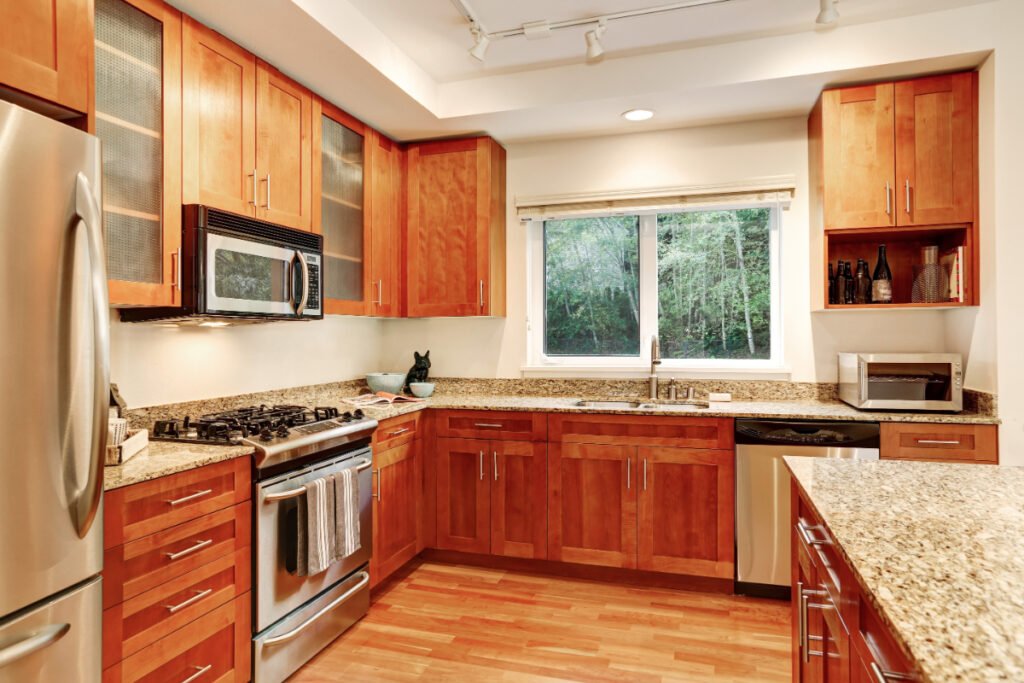
Generally, the weight-carrying capacity of a plywood cabinet depends on its thickness. Still, a ½” plywood can roughly take about 35 pounds of weight per square foot, whereas a 1” plywood will support approximately 164 pounds per square foot.
That means, if you have a small cabinet, roughly measuring about 3 X 1 X 1, with a 1” thick ply, you can still load it to about 500 pounds or 220 kgs, provided that you nail it from both sides.
So in simple terms, you can put a lot of things in your plywood cabinet, and you won’t need to worry about it until the wood warps.
To make the cabinet even stronger, always double-check the direction of the ply grains and ensure that they run along the longest length of the cabinet.
How Much Weight Can MDF Cabinets Hold?
A medium-sized MDF cabinet, roughly measuring about 3 X 1 X 1 foot, will successfully hold about 35 pounds or 15 kgs per square foot. However, you can only add a maximum weight of 80 lbs if you directly attach it to your drywall or plasterboard.
On the other hand, if screwed on brick walls, these cabinets will easily hold up to 300 lbs or 136 kg of weight.
In layman’s terms, a single, wall-mounted MDF cabinet will hold approximately 20-25 dinner plates, 2-3 grocery or grain bags, fruit tins, pots, and pans without sagging much.
If you use an 18mm MDF, screw it at regular intervals of about 500mm c/c for an optimal weight-carrying capacity. And, if you are using a 20mm MDF, screw it at a distance of not greater than 700mm c/c.
How Much Weight Can Melamine Or Laminate Cabinets Hold?

A standard, 18mm thick melamine cabinet holds about 35 pounds per square foot, provided that it is attached to both ends of the wall with coarse-threaded drywall studs and secured correctly.
In other words, a 3 X 1 X 1-foot cabinet will hold about 100-150 lbs or 68 kgs in total, enough to store plates, appliances, and grains together.
You can further strengthen your melamine upper cabinet by adding a solid wood nose to its base, which prevents sagging and helps improve the kitchen cabinets’ weight capacity.
Melamine is very brittle and can split if you screw it very close to the edge. So, always put your screws at least 2 feet away from the edge.
Signs That Your Kitchen Cabinets Are Overburdened
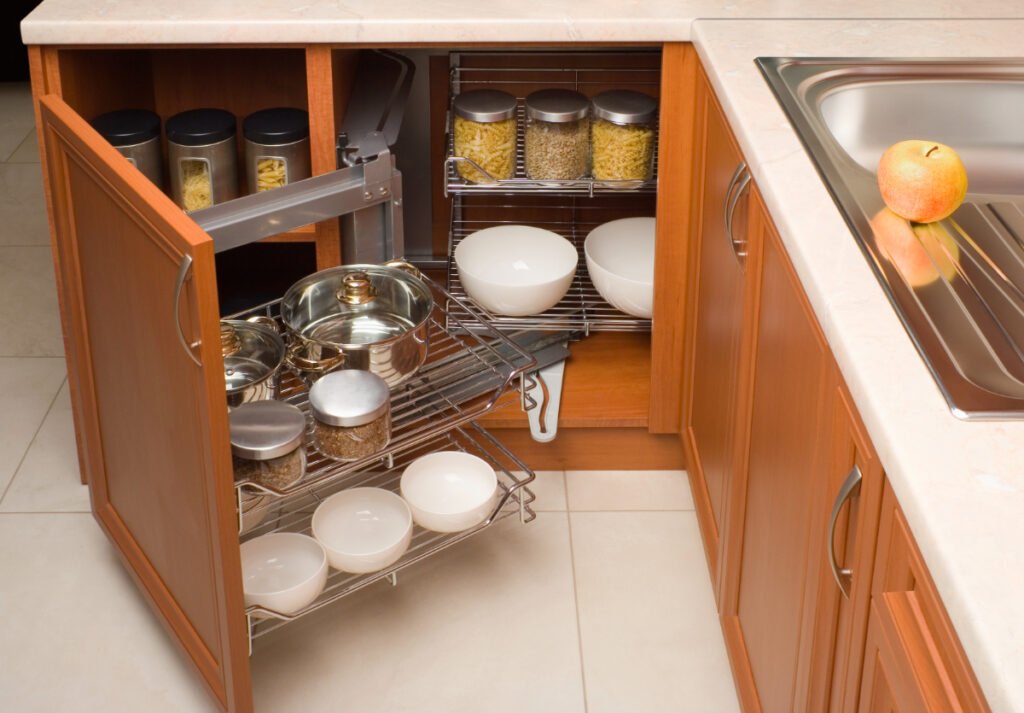
Kitchen cabinets are, without a doubt, the best tools for organizing and storing kitchen items, but they do have limitations. When overburdened, cabinets might come crashing down and damage countertops and stoves. Hence, it’s always better to respond to the signs of overburdening firsthand and prevent a mishap later.
- Bent Cabinet Box: A bent kitchen cabinet box or shelf can be tough to spot, as the warping takes place gradually. So, it’s advisable to frequently inspect the cabinet’s alignment using a drop level and note the deflections.
- Loose Screws: An overburdened cabinet will always force screws out of their positions. So, if you see any screws coming out, add additional fasteners and secure them beforehand.
- Cracks along the sides: Excess burden on the cabinets causes cracks on the side ply or fiberboard. Eventually, cracks may also develop on the supporting walls and ceiling and may cause the cabinet to fall.
- Moisture seepage: Overburdened cabinets are slightly deformed and may allow moisture and heat to seep into the joists and cause damage. So, if you notice water or termites inside, apply a sealant right away.
How To Pick A High-Load-Carrying Cabinet?
- Use Solid Wood, Ready To Install Cabinets: RTA cabinets, such as IKEA cabinets or plywood cabinets, have more shear strength. Thus, they will take on screws and fasteners much more effectively than other materials and increase the overall efficiency & load-bearing capacity.
- Use a Full-Height Back Panel: A ¾-inch full-height back panel holds onto rails, fasteners, and studs, bringing more stiffness and strength to the cabinet.
- Use Heavy-Duty Drawer Glides: High-quality cabinet drawer glides prevent sagging, thus relieving your cabinet frame of the drawer load and strengthening it further.
- Pick a Framed Cabinet: A traditional, framed cabinet supports hinges and fasteners in a better way, making it more stable than frameless cabinets.
- Get a Certified Cabinet: Always buy a cabinet certified by the Kitchen Cabinet Manufacturers Association so that you will have a cabinet that’s already tested for 600 pounds weight, and you won’t have to worry much.
- Choose a Self-Closing Drawer Slide: A self-closing, ball-bearing cabinet drawer slide will remove the excess load off your cabinet frame and strengthen your kitchen cabinets.
Do’s For Reinforcing Kitchen Cabinets To Carry More Load:
- Use good quality, 2-inch wide wall cabinet frames to provide additional stability to your cabinet box and help it carry more load. But if you have frameless cabinets, use 1-inch screws to secure them directly to the ceiling.
- Add typical furniture board braces to every corner of your custom cabinet to strengthen it further.
- Ask your cabinet contractor to add simple plywood I-beams to extend your cabinet box’s durability and load-carrying capacity. Plus, it will also speed up the installation process.
- Have annual maintenance for your wall studs to check for any damage due to moisture or termites, and replace all the rotten studs for efficient cabinetry.
- Always use larger head screws like Robertson screws to anchor your cabinetry.
Don’ts For Reinforcing Kitchen Cabinets:
- Avoid particle board cabinets, braces, or supports as they are comparatively weaker and will carry only about 35 pounds of weight. However, you can still use them for your cabinet doors to save costs, just like IKEA kitchen cabinets.
- Do not compromise the quality of the wall studs and use them at a distance of about 1-foot c/c for an optimal weight carrying capacity.
- Never use a regular flat-headed screw for the kitchen cabinets, as it might dismount quickly and cause damage.
How Much Weight Can Kitchen Drawers Hold?
Generally, cabinet drawers carry about 40-50 pounds or 18kgs weight, while large, heavy-duty drawers can even carry up to 75 pounds. However, the load-carrying capacity depends on the manufacturer, and it’s best to check the drawer box specifications before installation.
Can You Hang The Cabinet On One Wall Stud?
Ideally, it’s always better to secure the cabinets to two wall studs, but if your kitchen layout doesn’t permit this, you can hang it from one wall stud. However, while doing so, ensure that you secure the cabinets next to it to two wall studs and screw their frames together for additional support.
Can You Hang Cabinets With Drywall Screws?
No, drywall screws can neither support concentrated loads nor can take the weight of any heavy kitchen appliance. They are helpful only to secure drywall to wood and cannot support kitchen cabinets.
Can Kitchen Cabinets Fall?
Yes, kitchen cabinets can fall due to incorrect installation or overburdening. Similarly, if your stove or kitchen sink is above your base cabinet, it will likely sag much faster and break if not braced properly. On the other hand, cabinets can also fall if their supporting stud wall warps, rots, or breaks.
Can You Reinforce the Kitchen Cabinets?
While you can reinforce your kitchen cabinets in several ways, the best one would be to install metal or plywood braces under the cabinets to take on the additional load of your dishes and appliances. Alternatively, you can even add extra screws for comparatively larger cabinets in the center.
Do You Reinforce Your Base Cabinets If You Have Concrete Countertops?
Yes, concrete countertops are heavy and weigh over 100 pounds per square foot. So it’s always good to provide additional support to the lower cabinets to take on the extra weight without sagging much.
Kitchen cabinets are undoubtedly the kitchen organizers, but you’ll need to make sure that you are not overburdening them to make them last longer. While most cabinets carry a considerable amount of your kitchen load, it’s always a good idea to set the limits, check the signs for damage, and respond to them for an ever optimal kitchen.
And, we hope our guide has given you enough idea about the standard load-carrying capacity of kitchen cabinets and some further reinforcements to increase it. Now, if you’re thinking further about painting your cabinets, don’t forget to check out our guide on ‘Can kitchen cabinets be painted?

